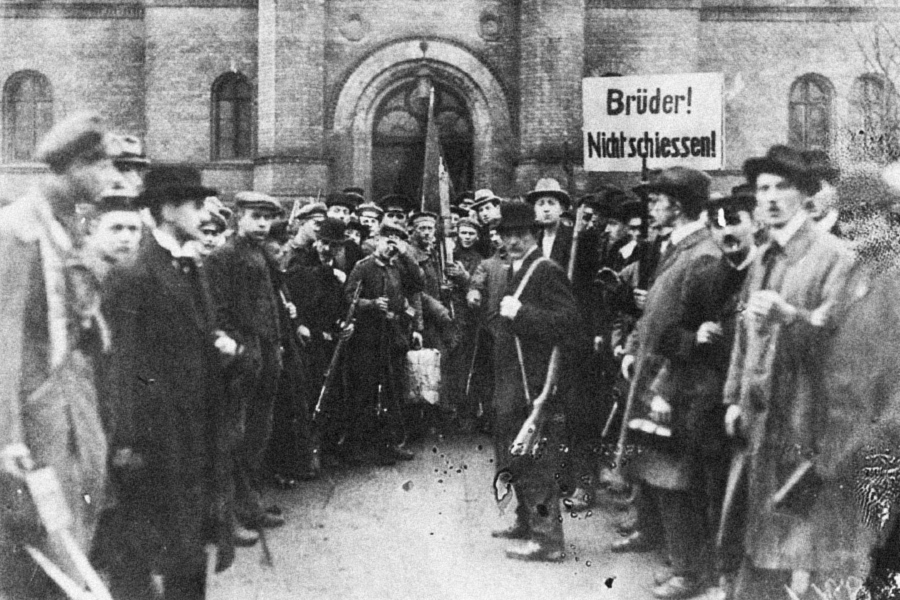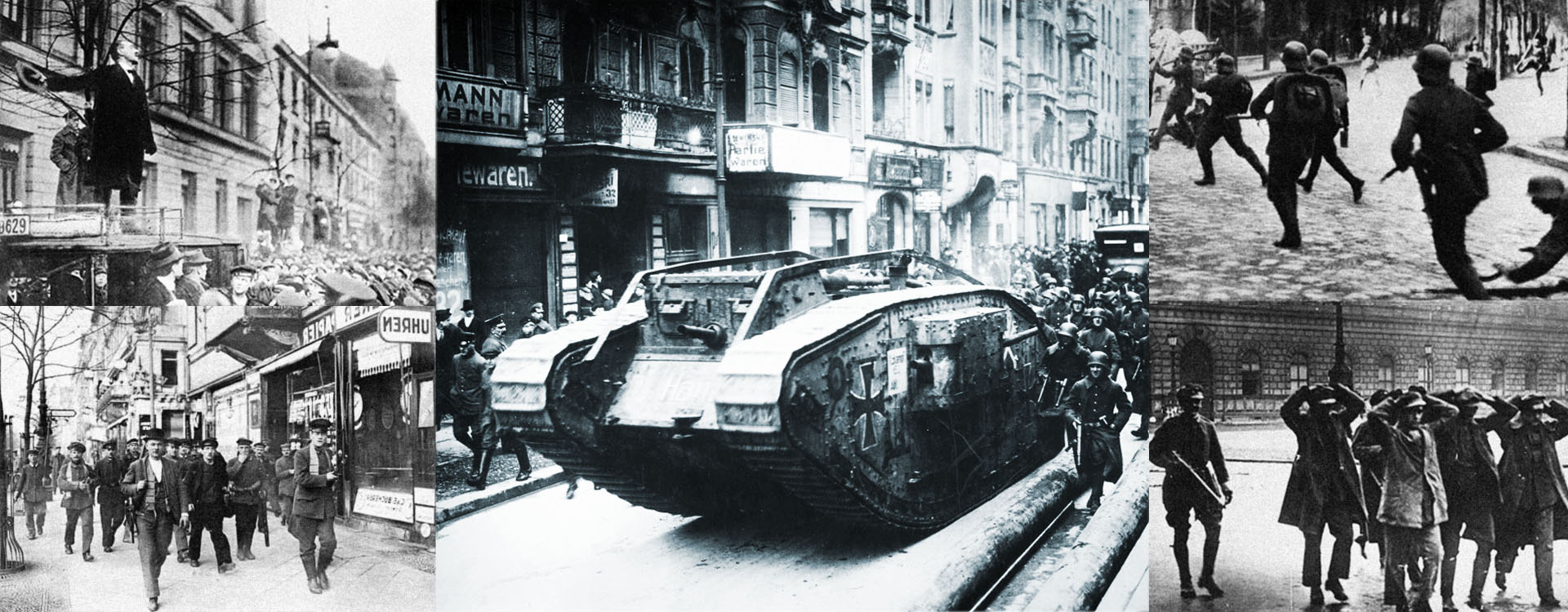One hundred years later, the forgotten German Revolution remains a powerful image of what might have been.
Writing in an August 2018 issue of the London Review of Books, Susan Pederson listed centenaries “queued up like planes coming into Heathrow: 1914, the Easter Rising, the Battle of the Somme, the Balfour Declaration, the Bolshevik Revolution, not to mention the Armistice, the Treaty of Versailles, and the Spanish flu epidemic still circling overhead.” Another then still circling seems to have escaped her attention: the German Revolution of November 1918. Pederson is not alone in ignoring this centenary, which has not even received the subdued remembrance the Bolshevik October was accorded at this time of declining faith in the Leninist creed. There have been a few responses: notably, the invaluable digitization of their collection of revolutionary publications by the German National Library and a London conference in October on “Living the German Revolution, 1918–19.” But there is no outpouring of books and articles such as one might have expected on such an occasion.
Part of the reason, I am sure, is the equivocal nature of the event. While indubitably a major social upheaval, the republic it produced led in a decade and a half to the founding of the Third Reich. From a left-wing perspective, the revolution itself left a bad taste: it was the Social Democratic government installed by the popular uprising that paved the way for Hitler by massacring the revolutionaries to its left—those who had opposed the world war seconded by the German Social Democratic Party (SPD) and demanded the direct exercise of political and economic power by the working class. This was not just a matter of facilitating the murder of a few leaders by protofascists in tactical alliance with the Socialists, but involved the killing of tens of thousands of rebellious workers over years of civil conflict. It is not surprising that the “lessons” of such a period can seem unclear.
Of course, lessons from the past are generally useless, as changing realities render earlier patterns of activity irreproducible. If the Leninist party is dead for all practical purposes today, it’s not so much because lessons of the past have been learned as because the purpose that gave it a function—the push to transform a preindustrial population into a waged working class in underdeveloped countries lacking a business class capable of doing so—no longer exists. If social democracy cannot be revived today, even in the impoverished form of Bernie-ism, it’s because the ongoing stagnation of the global economy rules out the accelerated accumulation of capital and rising real wages that gave such movements meaning in the past.
On the other hand, there are historical moments that reveal structural truths about the social system that nonetheless have enduring significance, without imparting doctrinal “lessons.” The Paris Commune was certainly among the most irreproducible of events, shaped as it was by the particular history of the French working class in the nineteenth century. No one understood this better than Marx, with his focus on the historical specificity of social realities, yet the actions of the Parisian population in 1871 clarified for him the fundamental idea that the destruction of capitalism requires at once the abolition of “that class property which makes the labor of the many the wealth of the few” and “the destruction of the state power” by means of revocable workers’ delegates directly administering social affairs.
“Based in the actual position of the working class as producers of social goods, the councils were structured by workers’ relationship to each other as workers, taking over the capitalist organization of production for their own purposes.”
The German Revolution was another such revelatory moment. Prior to the First World War it had seemed axiomatic to revolutionaries that the key to the abolition of capitalism was the creation of socialist organizations. For some, these were to be small conspiratorial groups; for others, mass electoral parties and trade unions; for others still, syndicalist unions which would one day transform themselves into agencies of social power. By the time the war had showed the impotence of the parties and unions in opposing the mutual slaughter of European (and, eventually, American) workers, the waves of mass strikes that had developed in various European nations in the early 1900s, independently of or even against the will of the labor organizations, had suggested the idea of the working class itself, not carefully constructed organizations, as a basis for radical struggle. This idea found another example in the factory-based protests against the war that broke out in Germany from 1916 on, coordinated by a network of “revolutionary shop stewards” (revolutionäre Obleute) who by the end of the war numbered several thousand. In May 1916, for instance, the shop stewards called a general strike in Berlin to protest the arrest of the Spartacist (left socialist) Karl Liebknecht, which drew some 55,000 workers from forty factories for two days. Another strike a year later “brought out between 200,000 and 300,000 workers from hundreds of factories and workshops, with marches and demonstrations throughout [Berlin] and at workplaces. Trade union officials were shouted down or ignored.”
Such developments provided both examples and underground organizational structures for the general uprising that took place in November 1918, when sailors ordered to attack the British fleet in a last doomed effort instead mutinied, arrested their officers, and spread their movement to nearby towns. Within weeks, social, political, and economic power had been assumed by councils of workers and soldiers across Germany. While many of the people in these councils were old SPD functionaries and Socialist union officials hoping to control the new movement, in big cities and industrial areas councils grouped workers elected as representatives of their workplaces, on the model of the wartime strike committees. This gave further content to the hitherto vague idea of “workers’ power.” Based in the actual position of the working class as producers of social goods, the councils were structured by workers’ relationship to each other as workers, taking over the capitalist organization of production for their own purposes. The essence of workplace organization, as one of the leading revolutionäre Obleute, Ernst Däumig, observed at the time, is that “in the workplace, all proletarians, no matter their party affiliation, stand on common ground” and are thus in a position to collectively define their collective interests. As with the Paris Commune, the direct, organized action of the producing class, on the scale of a whole society, raises the possibility of the joint abolition of wage labor and the state. As in the Commune, the essential principles of the council are the revocability of delegates and its substitution—to use Marx’s phrase—of “the administration of things” for the state’s administration of people in the interest of a ruling class. Responding not to theoretical or left-organizational imperatives, but to the practical requirements of revolutionary struggle, the specific forms taken by the workers’ council are determined by the conditions under which it arises: as Däumig put it, “its formation will never follow a set of bureaucratic rules. Rather, it will take on its exterior form and its tactics according to the demands of a particular revolutionary situation and a particular revolutionary development.”

Meanwhile, leaders of the SPD had assumed state power, as the wartime government disintegrated and the Kaiser abdicated. They took on the task of restoring social order. The new chancellor Friedrich Ebert made a deal with General Groener, chief of the army: in return for military support, the Socialist government would give the military a free hand to move against the workers’ councils. It was clear to all that the two rival powers, the council system and the nascent republic, could not long coexist. Things came to a head when the SPD called for elections to a National Assembly, which would form a government, taking power away from the network of councils. A national congress of workers’ councils, dominated by the SPD, voted to support elections to the Assembly, signing its own death warrant. In early January 1919, as the governing Socialists moved to solidify state power, leftist workers attempted to defend the council system in the streets and workplaces; they were crushed by armed force. While these struggles did not come to a complete end until 1923, with the failure of the last leftist uprising, the fate of the councils was sealed from the start by the refusal of the majority of the German working class to support the principle of their own direct administration of social affairs.
In retrospect, this was not surprising. People were unwilling to fight a civil war after the sufferings of the world war. The end of the war and the fall of the imperial government seemed like great accomplishments already, which had in fact taken a lot of effort. And the new republic was, after all, in the hands of Socialists—leaders of the party to whom the workers had looked for half a century to solve their problems of work and life. But the price paid for giving up was immense—the restabilization of German capitalism, the rise of new right-wing social forces, and ultimately a war that killed seventy million people.
Nonetheless, as a participant in these events later reflected, “revolution, which for so long had been a mere theory and a vague hope, had appeared for a moment as a practical possibility.” We live today under very different circumstances from those that gave rise to the German Revolution: notably, the radical reshaping of a now-global working class and the disappearance of the ideas and organizations of the left as it existed in the late nineteenth and early twentieth centuries. The events of 1919 showed that that left was a part of developing capitalism, organizing the labor market, and providing a structure for the containment of working-class rebellion. Its disappearance throws us for orientation onto the actual structure and development of contemporary capitalism. The German Revolution demonstrated the obsolescence of the older ideas and organizations of the left, as well as the consequences for the working population of their failure to understand this. At the same time, the example it gave of workers’ seizure for their own purposes of the position capitalism has made for them—one of actual subjection but also of potential power—still gives content to the idea of social revolution as a practical possibility.





